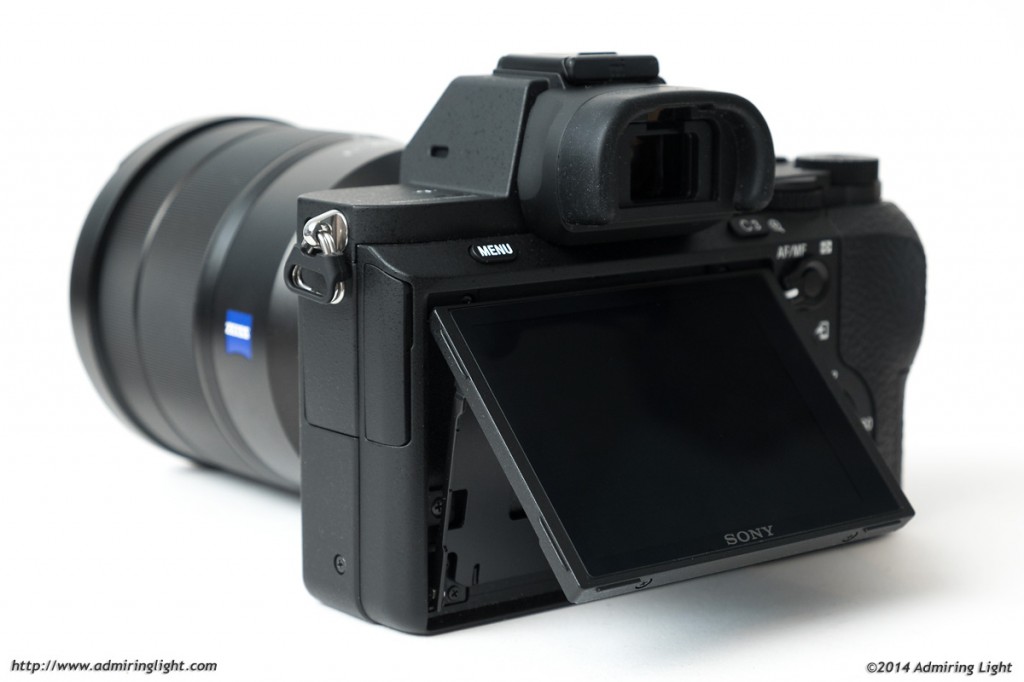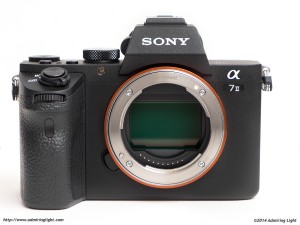Viewfinder and Rear Screen
The A7II features more or less the same viewfinder that is present in the original A7. The finder is a 2.3 million dot finder with 0.71x magnification, which gives the viewfinder a size similar to many full-frame DSLRs. The viewfinder is clear and has good color response, though I have to admit to being slightly underwhelmed after shooting with the Fuji X-T1’s enormous finder for the past year. However, the A7 II’s viewfinder is still one of the better viewfinders on the market, and I didn’t notice any appreciable lag or slowdown in indoor environments.
The rear screen is a 3″ 1.2 million dot screen that is extremely good. Viewing angles are excellent and the display is clear, rich and has great contrast. Colors are fairly accurate as well. The rear screen also is on a tilt mechanism like most of the E-mount cameras, which can tilt flat to point up at 90 degrees, or down at approximately 45 degrees. The tilting mechanism is, like the rest of the camera, very robustly constructed. It’s a shame that Sony still doesn’t feel the need to make the rear screens on their recent cameras touch sensitive, which would add a nice added dimension to shooting with the camera.

Autofocus and Performance
One of the things that the A7 and A7R were sometimes criticized for was a somewhat average responsiveness with regards to autofocus performance. While I didn’t have any issues with the autofocus when I reviewed the A7 last year, I did notice that the A7II has stepped up the game a bit. The camera can now track motion at the maximum burst rate instead of the reduced 2.5fps of the A7, and phase detect sites now cover almost the entire sensor.

I found autofocus to be very quick and very accurate on the A7II. For the most part, it felt indistinguishable in use from the autofocus on my a6000, which has one of the best AF systems in the mirrorless world. Single shot situations, even in dimmer light, locked on quickly and surely.
I didn’t do a ton of shooting in continuous autofocus situations, but I did throw on my Sony 18-105mm f/4 to test how it tracked motion. Zoomed out to 105mm and shooting wide open at f/4, the A7 II was able to maintain accurate focus placement through the vast majority of shots I took of cars moving towards me. I was shooting at the maximum frame rate of 5 fps, and in general, 5 of the 6 on average tended to be dead-on in focus. It’s hard to ask much more from a mirrorless camera in this situation.
The maximum frame rate of 5 frames per second is certainly not going to endear the camera to action shooters, but it’s a sufficient speed for most photographers. While the burst rate isn’t anything noteworthy, I was glad to see that Sony did concentrate somewhat on improving overall camera performance.
The A7 II has gotten that last little bit of lag out of the camera, save for a small delay on startup. Overall, the camera operates quickly and surely, and is ready when you need it to be ready. Shutter lag is acceptable, card write speeds are quick and image review is snappy. Ultimately, the improved ergonomics coupled with a bit faster operation make the A7 II melt into the background when shooting, which is exactly what a good camera should do.





Leave a Reply